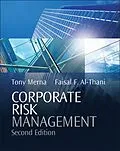The book analyzes, compares, and contrasts tools and techniques
used in risk management at corporate, strategic business and
project level and develops a risk management mechanism for the
sequencing of risk assessment through corporate, strategic and
project stages of an investment in order to meet the requirements
of the 1999 Turnbull report. By classifying and categorizing risk
within these levels it is possible to drill down and roll-up to any
level of the organizational structure and to establish the risks
that each project is most sensitive to, so that appropriate risk
response strategies may be implemented to benefit all stakeholders.
"The new edition of this book provides a clear insight into the
intricacies of corporate risk management and the addition of the
case study exemplars aids understanding of the management
of multiple projects in the real world."
--Professor Nigel Smith, Head of the School of Civil
Engineering, University of Leeds
Autorentext
Dr Tony Merna, BSc, MPhil, PhD, graduated with a Master of Philosophy degree from UMIST for his work on risk management in corporate organisations. Tony then gained a Doctor of Philosophy degree from UMIST for his research into the assessment of risks in portfolios of projects. Tony is currently working for a London based Investment Boutique focusing in Structured Finance; more specifically infrastructure.
Dr Faisal F. Al-Thani, BSc, MSc, PhD, is Senior Director and Head of Business Development Middle East for Maersk Oil Qatar. A petroleum engineer by profession, he has over 21 years' experience in the planning, design, operation, maintenance and finance strategies of oil and gas projects. Faisal is also a board member of the Marsh International Risk Council.
Zusammenfassung
The book analyzes, compares, and contrasts tools and techniques used in risk management at corporate, strategic business and project level and develops a risk management mechanism for the sequencing of risk assessment through corporate, strategic and project stages of an investment in order to meet the requirements of the 1999 Turnbull report. By classifying and categorizing risk within these levels it is possible to drill down and roll-up to any level of the organizational structure and to establish the risks that each project is most sensitive to, so that appropriate risk response strategies may be implemented to benefit all stakeholders.
"The new edition of this book provides a clear insight into the intricacies of corporate risk management and the addition of the case study exemplars aids understanding of the management of multiple projects in the real world."
Professor Nigel Smith, Head of the School of Civil Engineering, University of Leeds
Inhalt
1 Introduction.
1.1 Introduction.
1.2 Why Managing Risk is Important.
1.3 General Definition of Risk Management.
1.4 Background and Structure.
1.5 Aim.
1.6 Scope of the Book.
2 The Concept of Risk and Uncertainty and the Sources and Types of Risk.
2.1 Introduction.
2.2 Background.
2.3 Risk and Uncertainty: Basic Concepts and General Principles.
2.4 The Origin of Risks.
2.5 Uncertainties.
2.6 Sources of Risk.
2.7 Typical Risks.
2.8 Perceptions of Risk.
2.9 Stakeholders in an Investment.
2.10 Summary.
3 The Evolution of Risk Management and the Risk Management Process.
3.1 Introduction.
3.2 The Evolution of Risk Management.
3.3 Risk Management.
3.4 The Risk Management Process Identification, Analysis and Response.
3.5 Embedding Risk Management into Your Organisation.
3.6 Risk Management Plan.
3.7 Executive Responsibility and Risk.
3.8 Summary.
4 Risk Management Tools and Techniques.
4.1 Introduction.
4.2 Definitions.
4.3 Risk Analysis Techniques.
4.4 Qualitative Techniques in Risk Management.
4.5 Quantitative Techniques in Risk Management.
4.6 Quantitative and Qualitative Risk Assessments.
4.7 Value Management.
4.8 Other Risk Management Techniques.
4.9 Country Risk Analysis.
4.10 Summary.
5 Financing Projects, their Risks and Risk Modelling.
5.1 Introduction.
5.2 Corporate Finance.
5.3 Project Finance.
5.4 Financial Instruments.
5.5 Debt 116
5.6 Mezzanine Finance Instruments.
5.7 Equity.
5.8 Financial Risks.
5.9 Non-Financial Risks Affecting Project Finance.
5.10 Managing Financial Risks.
5.11 Risk Modelling.
5.12 Types of Risk Software.
5.13 Summary.
6 Portfolio Analysis and Cash Flows.
6.1 Introduction.
6.2 Selecting a Portfolio Strategy.
6.3 Constructing the Portfolio.
6.4 Portfolio of Cash Flows.
6.5 The Boston Matrix.
6.6 Scenario Analysis.
6.7 Diversification.
6.8 Portfolio Risk Management.
6.9 Cross-Collateralisation.
6.10 Cash Flows.
6.11 An Example of Portfolio Modelling.
6.12 Summary.
7 Risk Management at Corporate Level.
7.1 Introduction.
7.2 Definitions.
7.3 The History of the Corporation.
7.4 Corporate Structure.
7.5 Corporate Management.
7.6 Corporate Functions.
7.7 Corporate Strategy.
7.8 Recognising Risks.
7.9 Specific Risks at Corporate Level.
7.10 The Chief Risk Officer.
7.11 How Risks are Assessed at Corporate Level.
7.12 Corporate Risk Strategy.
7.13 Corporate Risk: An Overview.
7.14 The Future of Corporate Risk.
7.15 Summary.
8 Risk Management at Strategic Business Level.
8.1 Introduction.
8.2 Definitions.
8.3 Business Formation.
8.4 Strategic Business Units.
8.5 Business Strategy.
8.6 Strategic Planning.
8.7 Recognising Risks.
8.8 Portfolio Theory.
8.9 Programme Management.
8.10 Business Risk Strategy.
8.11 Tools at Strategic Business Unit Level.
8.12 Strategic Business Risk: An Overview.
8.13 Summary.
9 Risk Management at Project Level.
9.1 Introduction.
9.2 The History of Project Management.
9.3 Definitions.
9.4 Project Management Functions.
9.5 Project Strate...
